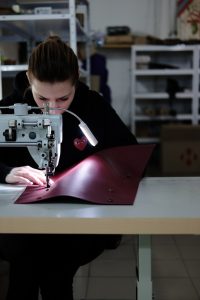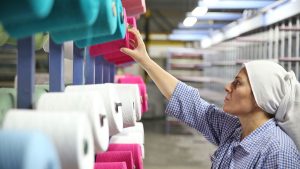Introduction
Imagine in a world without textiles. It’s nearly impossible because textiles touch our lives in so many ways. is particularly true for clothing, the primary focus of this article. Clothes provide comfort and protection while allowing individuals to express themselves. Beyond personal expression, the textiles industry is a significant part of the global economy employing hundreds of millions of people worldwide. However, the way we currently design, produce, and use clothes has several drawbacks that need urgent attention and transformation.
The Linear Textiles System: Current Challenges

Resource Consumption and Waste
The textiles industry predominantly operates on a linear model: extract resources, produce goods, use them briefly, and then discard them. This linear approach leads to significant wastage. For instance, more than USD 500 billion is lost yearly due to underutilization and lack of recycling of clothing. The disposal of textiles often ends in landfills or incineration, leading to additional environmental costs.
Environmental Impacts
The environmental impacts of the current textiles system are particularly alarming. Textiles production emits around 1.2 billion tonnes of greenhouse gases annually—more than the combined emissions from international flights and maritime shipping. Hazardous substances used in production not only affect the health of textile workers and wearers but also escape into the environment. Additionally, washing garments release plastic microfibres into oceans, contributing significantly to ocean pollution.
Towards a Circular Textiles Economy
Redefining the System
This article outlines a vision for a sustainable textiles economy, aligning with the principles of a circular economy. In a new textiles economy, clothes, textiles, and fibers are kept at their highest value during use and re-enter the economy afterward, never ending up as waste. This vision complements current efforts toward making the textiles system more sustainable by minimizing negative impacts.
Economic, Societal, and Environmental Benefits
The shift towards a circular textiles economy promises substantial economic, societal, and environmental outcomes. A circular system reduces waste, promotes the efficient use of resources, and minimizes environmental degradation. It creates new business opportunities and jobs, fostering economic growth while advancing societal well-being.
Global Commitment and Innovation
Systematic Changes Needed
Transforming the textiles industry to usher in a new textiles economy requires a system-level change involving unprecedented commitment, collaboration, and innovation. Existing sustainability initiatives should be complemented by a concerted global effort matching the scale of the opportunity. Such an approach involves rallying key industry players and stakeholders behind the objective of a new textiles economy.
Coordinated Efforts
Establishing a coordinating entity to ensure alignment and maintain the pace of system transformation is crucial. This entity would set ambitious joint commitments, kick-start cross-value chain projects, and reinforce complementary initiatives, maximizing the potential for success.
Voices of Industry Leaders
Support from Global Leaders
Leaders from various sectors have voiced their support for a new textiles economy:
- Karl-Johan Persson, CEO, H&M Group: “This groundbreaking report lays the foundation for a new mindset and creates a shared vision for a circular fashion industry.”
- Greg Stanton, Mayor, City of Phoenix: “Our city is working on creative solutions to redirect textiles from the waste stream and back into the circular economy as a valuable resource.”
- Leslie Johnston, Executive Director, C&A Foundation: “Through our partnership with the Ellen MacArthur Foundation, we are pleased to support this report towards a circular fashion industry.”
Industry Initiatives

Companies like Nike and organizations like the Sustainable Apparel Coalition emphasize the need for systemic innovation and collaboration. Nike, for instance, is pursuing new business models that move away from linear models of the past, depending on disruptive partnerships across a broader textile ecosystem.
Environmental Sustainability
Tim Kasten, Deputy Director, UN Environment Economy Division highlights the growing leadership in political and business sectors towards sustainable textiles. “This report will inspire new solutions and practices to transform the textile value chain,” he says.
Practical Steps Towards Circularity
Innovations in Textiles
The Circular Fibres Initiative and collaborations with the Ellen MacArthur Foundation intend to bring the circular economy to scale within the textiles industry. Innovative products like Lenzing Group’s RefibraTM branded lyocell fibers are closing the loop by using cotton scraps from the value chain, providing the vision and first steps toward a regenerative system for fibers.
Coordinated Industry Efforts
Various organizations, such as the Hong Kong Research Institute of Textiles and Apparel (HKRITA) and Global Fashion Agenda, are excited about the shift towards a new textiles economy. Industry leaders believe that such a transformation offers unprecedented business opportunities, financial and environmental benefits, and the necessary arguments for change.
Real-World Examples and Commitments
Case Studies
The British Heart Foundation, which reuses thousands of tonnes of clothing annually, demonstrates the potential for improving the circularity of textile flows. Their charity retail model not only improves the environmental footprint of textiles but also fosters social and economic resilience.
Collaborative Platforms
Organizations like the Cradle to Cradle Products Innovation Institute and the Fashion Positive initiative are actively involved in creating a circular framework for the textiles economy. These platforms encourage other organizations, businesses, and governments to take immediate action towards achieving circularity.
Conclusions from the Report
Broad Impacts
The report establishes a foundation for rethinking textile production and use throughout the entire value chain. It encourages understanding the true impact of the fashion industry by examining the value chain of textiles, from fibers to finished products. This comprehensive understanding can help designers and fashion businesses worldwide rethink their systems for sustainable solutions.
Transformative Vision
This report paints a clear picture of the current problems in the textile industry and offers a road map for necessary systemic changes. The goal is to move from a linear system to a regenerative and circular model, ensuring that textiles remain valuable resources rather than waste.
Toward a Sustainable Future
Next Steps
To achieve a circular textiles economy, strong political will and collaborative efforts are essential. The report aims to inspire new stories of success, solutions, and practices from all industry actors. The hope is for the concept of textile waste to become a thing of the past, creating a sustainable and resilient future.
Encouraging Industry Leadership
Leaders such as Eva Kruse, CEO of Global Fashion Agenda, emphasize the importance of stakeholders collaborating pre-competitively to transition into a circular textiles system. Anna Maria Rugarli of VF EMEA also acknowledges the unique position of the apparel industry in achieving a new textiles economy based on a circular system, which offers innovative design opportunities and captures economic value.
Conclusion
The shift towards a new textiles economy is imperative for a sustainable future. The compelling vision outlined in this article highlights the urgent need for systemic changes in the textiles industry. By adopting a circular economy, the textiles industry can mitigate its environmental footprint, enhance resource efficiency, and provide economic and societal benefits. Transforming the industry requires collective action, innovation, and unwavering commitment from industry leaders, governments, and communities. Only through such a concerted global effort can the textiles industry truly become sustainable and resilient for future generations.
This transformative journey towards a circular textiles economy is not merely an option but a necessity. As we transition to this new paradigm, let us embrace the opportunity to redesign fashion’s future, ensuring that textiles remain valuable resources, fostering a healthier planet, and promoting human well-being.




